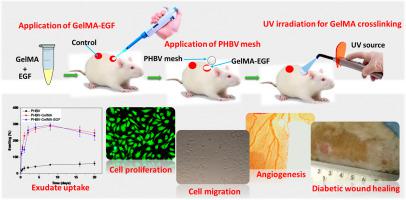Biomaterials Advances ( IF 5.5 ) Pub Date : 2020-09-18 , DOI: 10.1016/j.msec.2020.111519 Robin Augustine , Anwarul Hasan , Yogesh B. Dalvi , Syed Raza Ur Rehman , Ruby Varghese , Raghunath Narayanan Unni , Huseyin C. Yalcin , Rashad Alfkey , Sabu Thomas , Ala-Eddin Al Moustafa

|
Management of chronic diabetic ulcers remains as a major challenge in healthcare which requires extensive multidisciplinary approaches to ensure wound protection, management of excess wound exudates and promoting healing. Developing wound healing patches that can act as a protective barrier and support healing is highly needed to manage chronic diabetic ulcers. In order to boost the wound healing potential of patch material, bioactive agents such as growth factors can be used. Porous membranes made of nanofibers generated using electrospinning have potential for application as wound coverage matrices. However, electrospun membranes produced from several biodegradable polymers are hydrophobic and cannot manage the excess exudates produced by chronic wounds. Gelatin-methacryloyl (GelMA) hydrogels absorb excess exudates and provide an optimal biological environment for the healing wound. Epidermal growth factor (EGF) promotes cell migration, angiogenesis and overall wound healing. Poly(3-hydroxybutyrate-co-3-hydroxyvalerate) (PHBV) membranes provide microbial, thermal and mechanical barrier properties to the wound healing patch. Herein, we developed a biodegradable polymeric patch based on the combination of mechanically stable electrospun PHBV, GelMA hydrogel and EGF for promoting diabetic wound healing. In vitro and in vivo studies were carried out to evaluate the effect of developed patches on cell proliferation, cell migration, angiogenesis and wound healing. Our results showed that EGF loaded patches can promote the migration and proliferation of multiple types of cells (keratinocytes, fibroblasts and endothelial cells) and enhance angiogenesis. In situ development of the patch and subsequent in vivo wound healing study in diabetic rats showed that EGF loaded patches provide rapid healing compared to control wounds. Interestingly, 100 ng EGF per cm2 of the patches was enough to provide favourable cellular response, angiogenesis and rapid diabetic wound healing. Overall results indicate that EGF loaded PHBV-GelMA hybrid patch could be a promising approach to promote diabetic wound healing.
中文翻译:

生长因子原位可光交联的聚(3-羟基丁酸酯-co-3-羟基戊酸酯)/明胶甲基丙烯酰基混合贴剂用于糖尿病伤口愈合
慢性糖尿病性溃疡的管理仍然是医疗保健领域的主要挑战,需要广泛的多学科方法来确保伤口保护,过量伤口渗出液的管理和促进愈合。迫切需要开发可以充当保护性屏障并支持愈合的伤口愈合贴片,以治疗慢性糖尿病性溃疡。为了增强贴片材料的伤口愈合潜力,可以使用生物活性剂,例如生长因子。由使用静电纺丝产生的纳米纤维制成的多孔膜具有用作伤口覆盖基质的潜力。但是,由几种可生物降解的聚合物制成的电纺膜具有疏水性,无法处理慢性伤口产生的多余渗出液。明胶-甲基丙烯酰(GelMA)水凝胶吸收多余的渗出液,并为伤口愈合提供最佳的生物环境。表皮生长因子(EGF)促进细胞迁移,血管生成和整体伤口愈合。聚(3-羟基丁酸酯-co-3-羟基戊酸酯)(PHBV)膜可为伤口愈合贴片提供微生物,热和机械屏障性能。本文中,我们基于机械稳定的静电纺丝PHBV,GelMA水凝胶和EGF的组合开发了可生物降解的聚合物贴剂,以促进糖尿病伤口的愈合。进行了体外和体内研究,以评估已开发的贴剂对细胞增殖,细胞迁移,血管生成和伤口愈合的影响。我们的结果表明,加载EGF的贴剂可以促进多种类型的细胞(角质形成细胞,成纤维细胞和内皮细胞)的迁移和增殖,并增强血管生成。该贴剂的原位发育和随后在糖尿病大鼠中的体内伤口愈合研究表明,与对照伤口相比,负载EGF的贴剂可提供快速愈合。有趣的是,每厘米2 100 ng EGF贴剂的数量足以提供有利的细胞反应,血管生成和快速的糖尿病伤口愈合。总体结果表明,EGF加载的PHBV-GelMA混合贴片可能是促进糖尿病伤口愈合的有前途的方法。











































 京公网安备 11010802027423号
京公网安备 11010802027423号